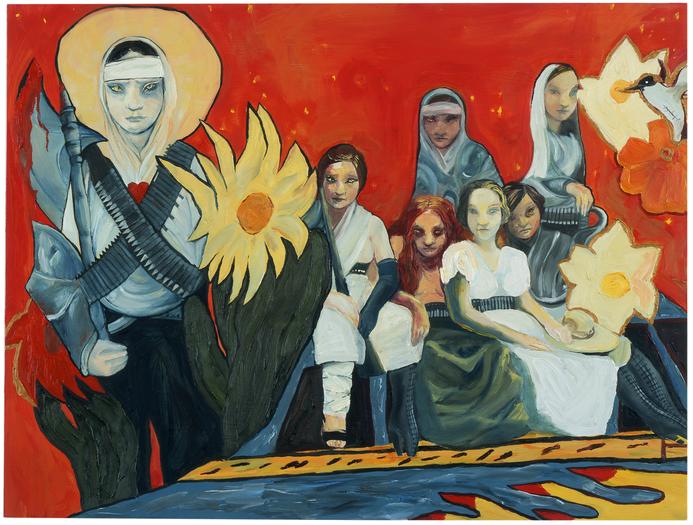Rita Ackermann
Listen to the Fool's Reproach
December 13, 2003 – January 17, 2004
Main Gallery
"I never believed in the attempt to renew art, but I do believe in the attempt to understand through art the vision where the painting takes up the foreground of the vision on fire, the blasphemy, the curse. Painting by painting, curse to curse, these progress to provide commentary, ventilation and elucidation because being on fire, corrosive, incisive, spurted forth from who knows what vortex of sub-maxillary, sub-spatular vitriol, they are there as if nailed in place, fated not to make another move. Mere shanks but ready to carry out their apocalypse for they have spoken too much of it to be born, and spoken too much in birth not to be reborn, and taken on body at last authentically. These works are produced magnetically and magically; therefore they are not representation or the figuration of a subject or a state of mind or fear, of a psychological element or event. They are purely and simply the reproduction of a magical gesture which I executed in true space with the breath of my lungs and my hands, with my head and two feet, with my trunk and my arteries, etc." (Words by Antonin Artaud, arrangement by Rita Ackermann)
Ackermann's title for her show (a quotation from William Blake's "The Marriage of Heaven and Hell") is an acknowledgement of the playful and naive elements in her work, but also an exhortation to look beyond them, remembering that the fool is also the truth-teller, or holy simpleton. It is a reference to the artist's abiding interest in madmen, visionaries, rebels and prophets - the figure of the outsider with insight - and a suggestion that the artist might be found in this company.
Working on a smaller scale than before, Ackermann has produced a cycle of fourteen works that feel intense and concentrated, condensing a cast of different personae and a painting vocabulary developed over more than a decade. Here are her cat-eyed, sweet and ferocious feral girls, rebel girls, luminous dancing girls drawn entirely in curves, demure self-portraits and goya-esque crones. The handling of paint varies as widely as the subject matter, from the precise, stiff rendering of "Lina", an autobiographical memory, to the swift, loose handling of "The Book Burners". The same painting can contain a livid impastoed sunset and a sinuous tree branch, or a gnarled tree drawn like a woodcut and a smooth, luminous buttock, or solid pillowy clouds above a swirling circle of figures.
Despite the diversity, the group reads as the interwoven stories of Ackermann's personal mythology, drawn from events in her life, from her wide reading and her visionary imagination. Everywhere are echoes, which send you groping for a source; searching Aesop's fables for the Wolf and the Cane, Norse mythology for a Wild Hunt, Shakespeare or Brecht or the Brothers Grimm for other puzzling scenes. Particularly pervasive is the mood of fairy tale, but of the dark and unsettling Slavic variety, true to Ackermann's Eastern European roots. Ultimately, though, we understand that all these influences and more are channeled into Ackermann's unique and singular imagination, to emerge again here as a vision of great sincerity, immediacy and directness. These works should remind us that Ackermann was the precursor to a generation of younger painters, and still appears the original and authentic visionary.
